Sandy Bridge Memory Scaling: Choosing the Best DDR3
by Jared Bell on July 25, 2011 1:55 AM ESTMemory Scaling with Overclocking
What happens when we increase the CPU clock speed on our Core i7-2600K from the default 3.5GHz to 4.8GHz; how will that affect memory performance? To find out, I ran the memory bandwidth tests again comparing DDR3-1333 CL9, DDR3-1600 CL9, and DDR3-2133 CL9 at both 3.5GHz and 4.8GHz CPU clock speeds. I also ran the most bandwidth intensive real-world test along with the least bandwidth intensive real-world test at the overclocked CPU speed to see if the faster CPU clock speed made any difference here as well.
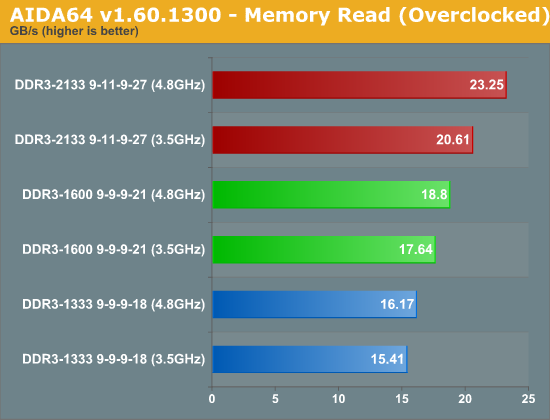
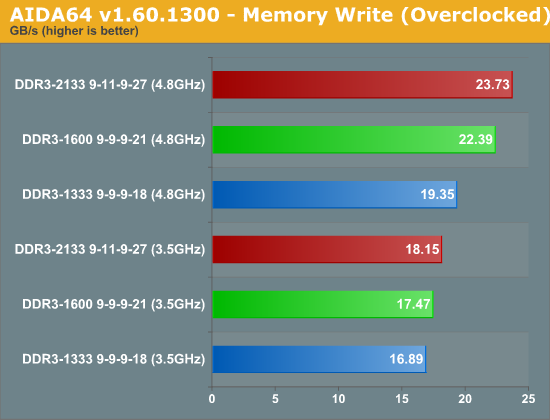
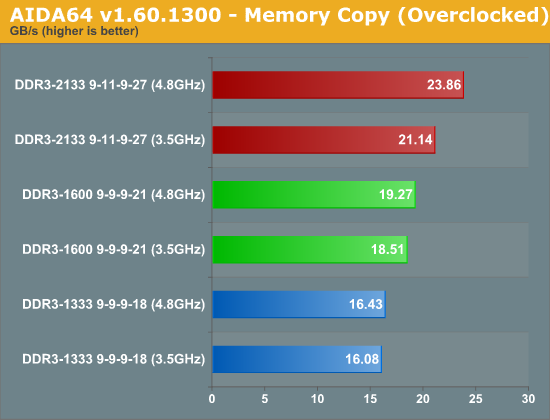
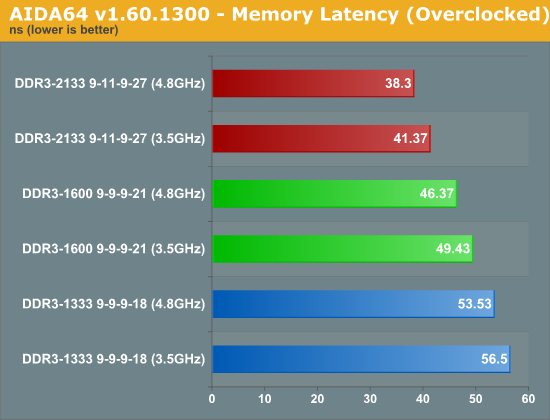
The AIDA64 memory benchmark shows that memory bandwidth does scale with CPU clock speed. Going from DDR3-1333 to DDR3-1600 showed a 14% boost on our stock CPU while showing a 16% boost on our overclocked CPU. Stepping up from DDR3-1333 to DDR3-2133 saw a 33% increase on the stock CPU and a 43% increase on our overclocked CPU. The copy and latency tests showed similar results. What's more impressive is that the write test showed a much larger 15% increase from DDR3-1333 to DDR3-1600 on the overclocked CPU compared to 3% on the stock CPU. Going from DDR3-1333 to DDR3-2133 increased write performance by 22% when overclocked compared to 7% when stock. While it's interesting to see how an overclocked CPU affects raw memory bandwidth, I'm much more interested to see how it affects our real-world benchmarks.
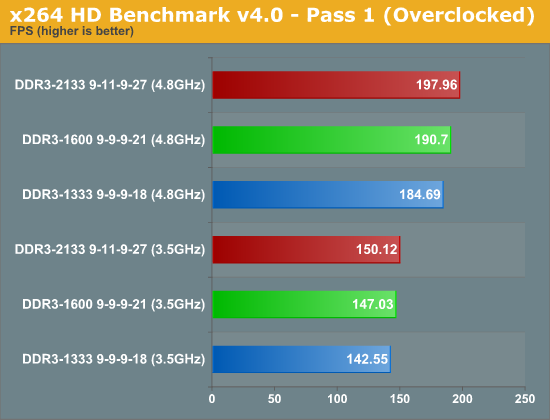

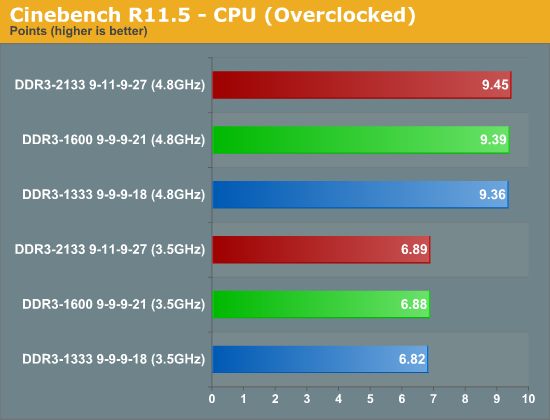
The extra bandwidth gained with the overclocked CPU doesn't exactly translate into much. The first pass of the x264 test reveals a 7% advantage for DDR3-2133 over DDR3-1333 on our overclocked CPU while the stock CPU shows a 5% increase. The increase for DDR3-1600 over DDR3-1333 is 3% for both our overclocked and stock CPUs. Once we move on to the second pass, there's no discernible advantage for faster memory on our overclocked system. The Cinebench test results are every bit as unimpressive with overclocking as at stock: overclocked or not, faster memory makes no real difference (though the faster CPU clock speed definitely helps a lot).










76 Comments
View All Comments
dfjgkheu - Tuesday, July 26, 2011 - link
believe you will love it.====( www )( bestniceshoes)( c o m ) ====
The website whol esale for many kinds of fashion shoes,
like the ni ke, jor dan, pra da, also including the jea ns,shirts,bags,hat and the decorations.
All the products are free ship ping, and the the price is competitive,
and also can accept the pay pal payment.
,after the payment, can ship within short time
vailr - Monday, July 25, 2011 - link
No discussion of differing voltages?A quick check for DDR3 at Newegg shows:
G.SKILL ECO Series 4GB (2 x 2GB) 240-Pin DDR3 SDRAM DDR3 1600
@ 1.35 volts & Cas Latency: 7
vs.
G.SKILL Ripjaws X Series 4GB (2 x 2GB) 240-Pin DDR3 SDRAM DDR3 1600
@ 1.50 volts & Cas Latency: 6
A more thorough consideration of these two DDR3 modules might be interesting.
For virtually the same money, aren't most people going to seek out DDR3 with the lowest possible CAS latency number, and also combined with the lowest possible voltage design?
I know that: I wouldn't consider buying any DDR3 memory modules with a (nominal) CAS latency higher than 7.
JarredWalton - Monday, July 25, 2011 - link
Just as we didn't test with ten different modules (for ease of testing), we didn't use different voltage memory. Whether your RAM is 1.5V or 1.35V, at the same timings and speed the performance should be identical (less than a 0.5% difference). And we did look at the effect of lower latency RAM; sure, at the same price buy lower latency and higher bandwidth RAM, but prices aren't the same, particularly on 2x4GB kits.Tchamber - Monday, July 25, 2011 - link
I'd like to see how these tests stack up against the tripple channel nehalem i7's.duploxxx - Monday, July 25, 2011 - link
compare with what an EOL platform? it was alreay known that there is no added value with memory speed testing on these systems, just like the previous gen., 1366 is dead testing has been done in the pastThis test just showed that it is a lot of wasted money and time investigated in this.
They better take the time and investigate further into Liano memory speed, something that really does scale with memory.
Finally - Monday, July 25, 2011 - link
It's already done, see Computerbase...JarredWalton - Monday, July 25, 2011 - link
We've done it as well for graphics applications:http://www.anandtech.com/show/4476/amd-a83850-revi...
We haven't done the application testing with different DDR3 on Llano, however.
banwell - Monday, July 25, 2011 - link
You can also get a nice 'free' bump in performance at 1600 by switching to 1T. Something the better quality memory will be able to do easily.AssBall - Monday, July 25, 2011 - link
I'm not sure why they didn't test 1T . It is a memory scaling article after all. Anyway TechReport did and their conclusions are about the same, I.E. unless you are overclocking and running synthetic benchmarks, it doesn't really matter.compudaze - Monday, July 25, 2011 - link
Lowering the command rate from 2T to 1T at DDR3-1600 doesn't necessarily mean you can do the same at DDR3-2133. Not all memory modules, CPU's and motherboards are creased equal. Testing all configurations at 2T kept the results comparable.